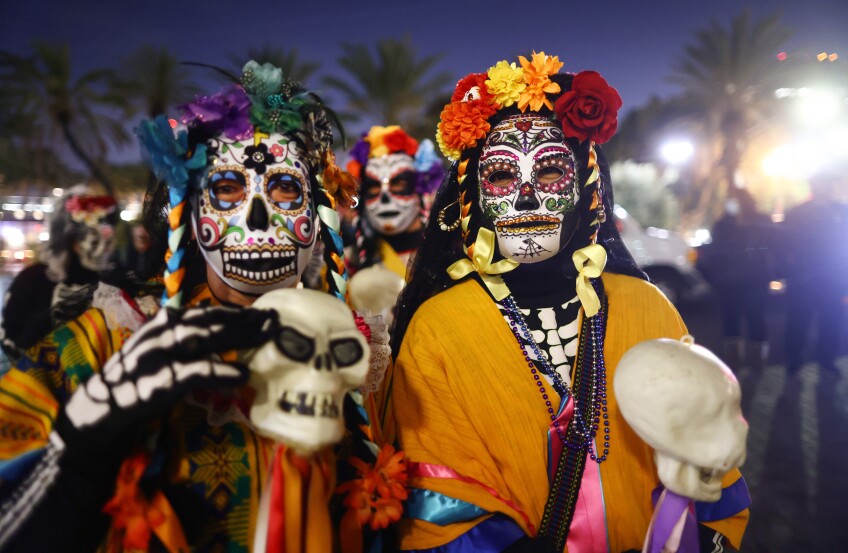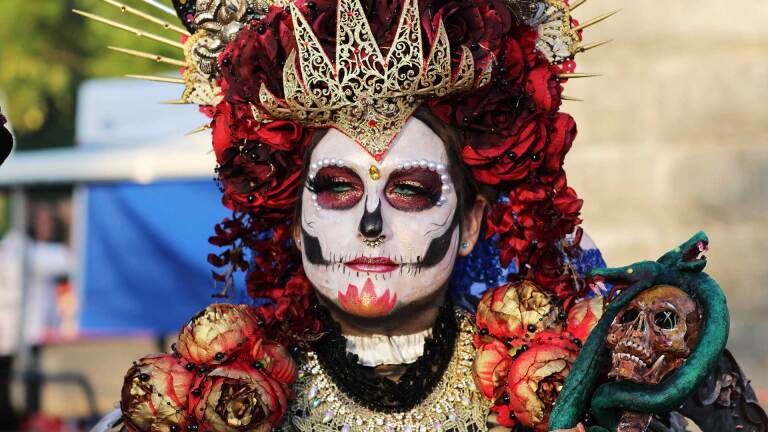Here's Where You Can Experience Día de los Muertos 2022 Celebrations In SoCal This Week

Halloween shares a common history with the three-day Mexican tradition of Día de los Muertos, or Day of the Dead — when we honor and remember our ancestors who have passed. Sometime in the 20th century, those two interrelated holidays grew apart, thanks to an over-commercialization of candy and costumes and the Hollywoodification of death and the spirit world as "horror."
Most of our Día de los Muertos celebrations have managed to retain their reverence for those on the other side, offering items including candy — in this case, usually calaveras (sugar skulls) — as gifts and offerings rather than tricks and treats. Given our proximity to Mexico and our history as Alta California under Mexican rule, we’ve been able to carry on the tradition of flowers and cakes and altars — and, of course, lots of calacas (skeletons) — right here in Southern California.
The annual celebration at Hollywood Forever Cemetery may be one of the largest and best-known in SoCal — or even the entire country — but there are plenty of other places to honor the dead throughout the Southland and beyond.
Whether it’s among the tombstones, in a traditional Mexican-American neighborhood, or at a cultural institution, here are the six best places in southern California to explore the rituals, flavors and decorations of this ancestral celebration.
1. Self Help Graphics & Art, Boyle Heights

Perhaps the oldest Day of the Dead commemoration in the country (49 years and counting), Día de los Muertos at Self Help Graphics is also one of the largest … and longest! Involving over 50 community organizations, and attended by 10,000 people of all ages, this unique program extends into an entire season of activities. (This year it began on October 8.)
On November 2, the celebration kicks off with SHG's Noche de Ofrenda, or "Night of Altars," from 6:30 p.m. to 9 p.m. This free event (advance registrations encouraged) takes place at the Self Help Graphics headquarters at 1300 East 1st Street, where guests may contribute photos of their loved ones to the Community Altar. Numerous other altars, produced by artists and community partners, will also be on display, while live poetry and musical performances entertain guests throughout the night.

The "main" event, however, occurs on Saturday November 5 at 4 p.m. with local Aztec dancers from Danza Chicomecoatl leading a walking procession from Mariachi Plaza to Self Help Graphics. To join in this free, family-friendly event, dress up in your favorite Día de los Muertos fashion and arrive by 3:30 p.m. The Muertos Market will be selling wares from artisans, artists, printmakers and designers. And — in a partnership with members of Vendedores en Acción, advocating for an equitable future for street food vendors in Los Angeles — street vendors will be sharing the flavors of their Boyle Heights neighborhood.
2. Olvera Street, Downtown Los Angeles

The merchants on Olvera Street in downtown L.A. have celebrated Dia de los Muertos for over 35 years — with the celebration evolving over the last three decades to incorporate the pre-Columbian, Aztec, Mayan and Catholic rituals honoring the dead. Today, Olvera Street celebrates Día de los Muertos over the course of nine days and nights, this year with free nightly programs having started on October 25 and running through Tuesday, November 2.
Every evening at 6 p.m., Teatro del Barrio presents the "Danza de la Muerte" theatrical performance on the stage at La Plaza — followed by a 7 p.m. Novenario Procession through El Pueblo Historical Monument, led by an Indigenous Aztec group (Grupo Tartalejo) and featuring Aztec dancers and participants dressed up as skeletons (a.k.a. "Living Muertos").
On display in the plaza are a number of community ofrendas/altars (on view daily from 10 a.m. to 9 p.m.), as well as face painting stations (for a charge) and a number of other entertainment offerings, including the musical group Cayambe and the dance troupe Ballet Bravo.
3. Third Street Promenade, Santa Monica

Nine sculptures of La Catrina — a.k.a. the Grand Dame of the Dead, often depicted by Mexican illustrator Jose Guadalupe Posada — on view throughout three blocks of the Third Street Promenade from October 28 through November 2. These 14-foot-high sculptures were created by Los Angeles-based artist Ricardo Soltero, who has also contributed decorations and scenery for Hollywood Forever's annual Día de los Muertos celebration.
Born in Nayarit, Mexico, Soltero uses such materials as papier-mâché, wood, fiberglass and recycled materials — and incorporates inspiration from his Mexican heritage in every piece he creates.

The public art exhibition is hosted by Downtown Santa Monica and welcomes visitors daily from 10 a.m. to 8 p.m. The sculptures will be viewable throughout the pedestrian promenade, between Wilshire Boulevard to the north and Broadway to the south. Although the promenade itself is closed to vehicular traffic, there are several city-run parking structures in the area that offer your first 90 minutes for free.
4. Bowers Museum, Santa Ana

One of the most intriguing and well-curated cultural institutions of Orange County is the Bowers Museum, whose vision is to celebrate world cultures through their artistic traditions. This year, you can visit on Sunday, November 6 to contemplate the dearly departed with family-friendly art projects, a mariachi concert and traditional dance performances at its annual Mexican Day of the Dead Festival, which takes place from 11 a.m. to 3 p.m. You can bring a photo of a loved one (or even a pet that has crossed the rainbow bridge) to add to their ofrendas.

Musical performances include classical guitarist Joel Aceves (in John M. Lee Court) and Los Cuates (playing traditional music of Mexico and East L.A.) and Mariachi Anacatlan and the Mariachi Kids in the Key Courtyard. Dance performances will feature folklórico dancers from Relampago del Cielo and Aztec dancers from Xipe Totec.
Admission is free — and if you can't make it there in person, a recording of the festival will be posted on the Bowers Museum Facebook page and YouTube channel a week after the event takes place.
5. Catalina Museum for Art and History, Avalon

Catalina Museum's 4th Annual Día de los Muertos Family Festival takes place this year on November 1 from 5 to 9 p.m. at the museum, located in the town of Avalon on Catalina Island. It's an opportunity to celebrate both life and death, with an Ofrenda/Altar & Art Contest to remember and honor loved ones who have passed.
Ofrendas are traditionally colorful and decorative, adorned with marigold flowers (cempasúchitl, which have become Mexico's national symbol for the festival), sugar skulls, candles (only battery-operated ones are allowed) and banners made from multi-colored sheets of paper cutouts (papel picado). Those building altars often also include favorite foods of those who've passed — including items like chocolate and pan de muerto. Judging will take place from 6 to 7 p.m., and cash prizes will be awarded to Best Ofrenda/Altar and Best Work of Art at 7:30 p.m. Participants from all ethnic and religious backgrounds are invited to participate.
Other festival features include a raffle, a tequila tasting, and performances by Mariachi Las Catrinas, local band Sin Frontera and Ballet Folklorico Quetzal. Festival admission is free, although food from local vendors will be available for purchase.

6. Old Town San Diego State Historic Park, San Diego
Considered by some as "the birthplace of California," Old Town San Diego was, indeed, the Golden State’s first non-native settlement, founded in 1769 with the establishment of a mission and a fort. At its center is the state historic park, which provides living history programs that focus on the Mexican and American period between 1821 and 1872.
The Day of the Dead celebration in Old Town San Diego first started in 2012. This year, from October 29 to November 2, you can see Día de los Muertos altar setups — both traditional and modern — on a self-guided or guided tour (starting at the Robinson-Rose Visitor Center at 3 p.m. daily) throughout several of the surrounding buildings and museums in the historic district, as well as the park’s annual "chalk graveyard." Many of the local restaurants are offering special programming and/or food and drink specials as well. Free parking, or take the Trolley.
On Tuesday, November 2, you can watch the procession down San Diego Avenue — starting at Twiggs Street and passing such landmarks as the Church of the Immaculate Conception and Whaley House Museum — from 6 to 8 p.m. A nearby food court and beer garden will offer items for purchase.







